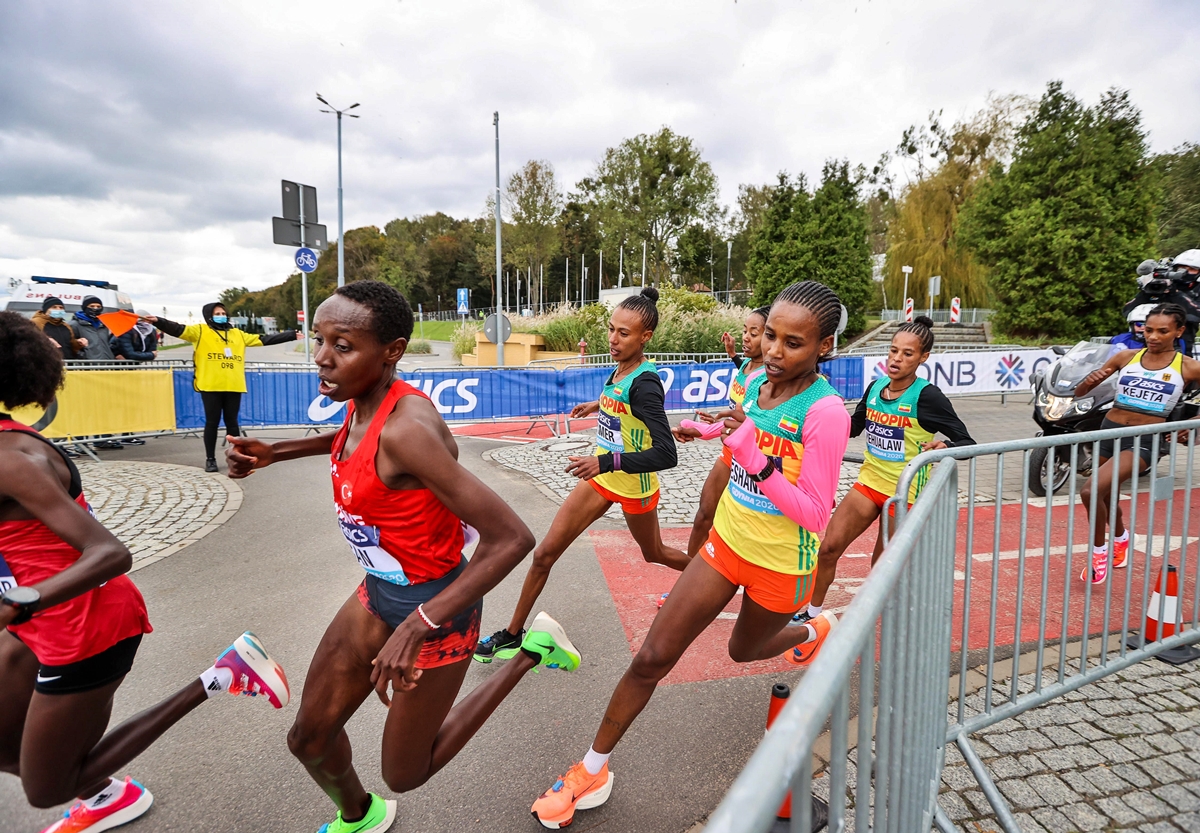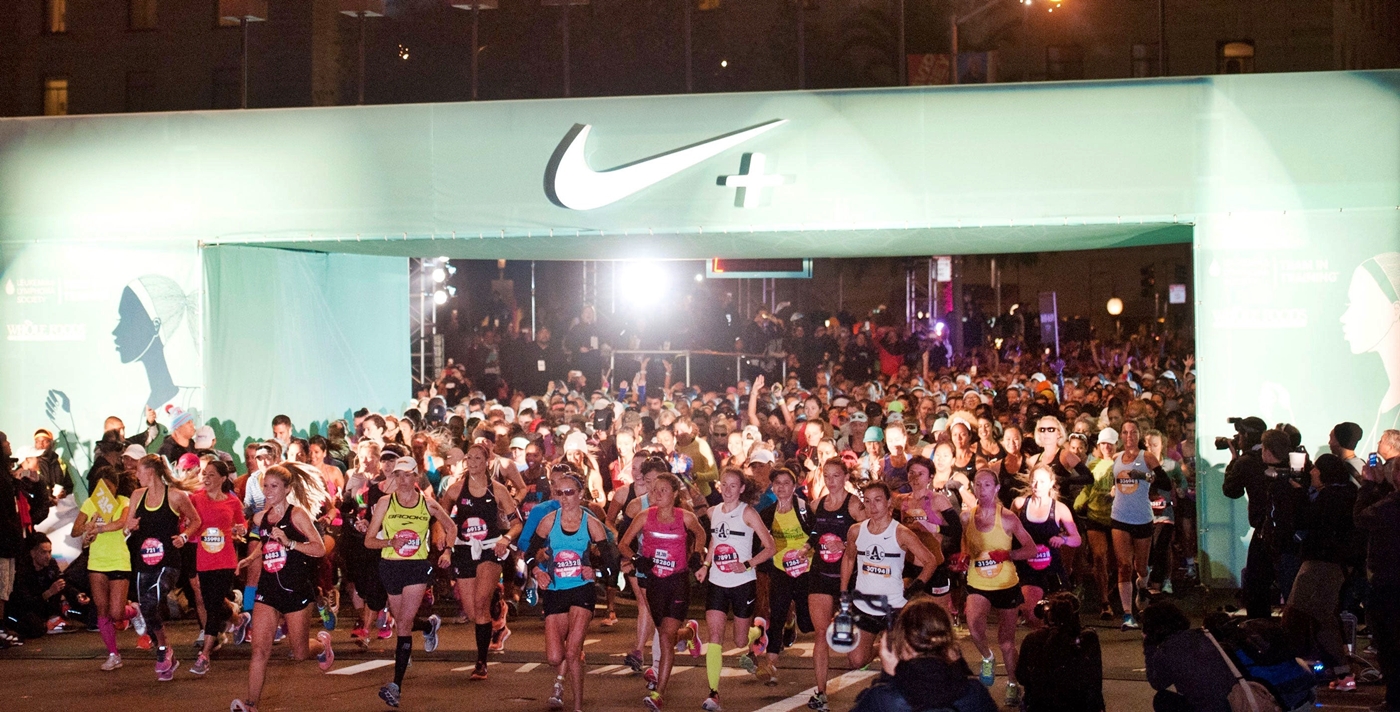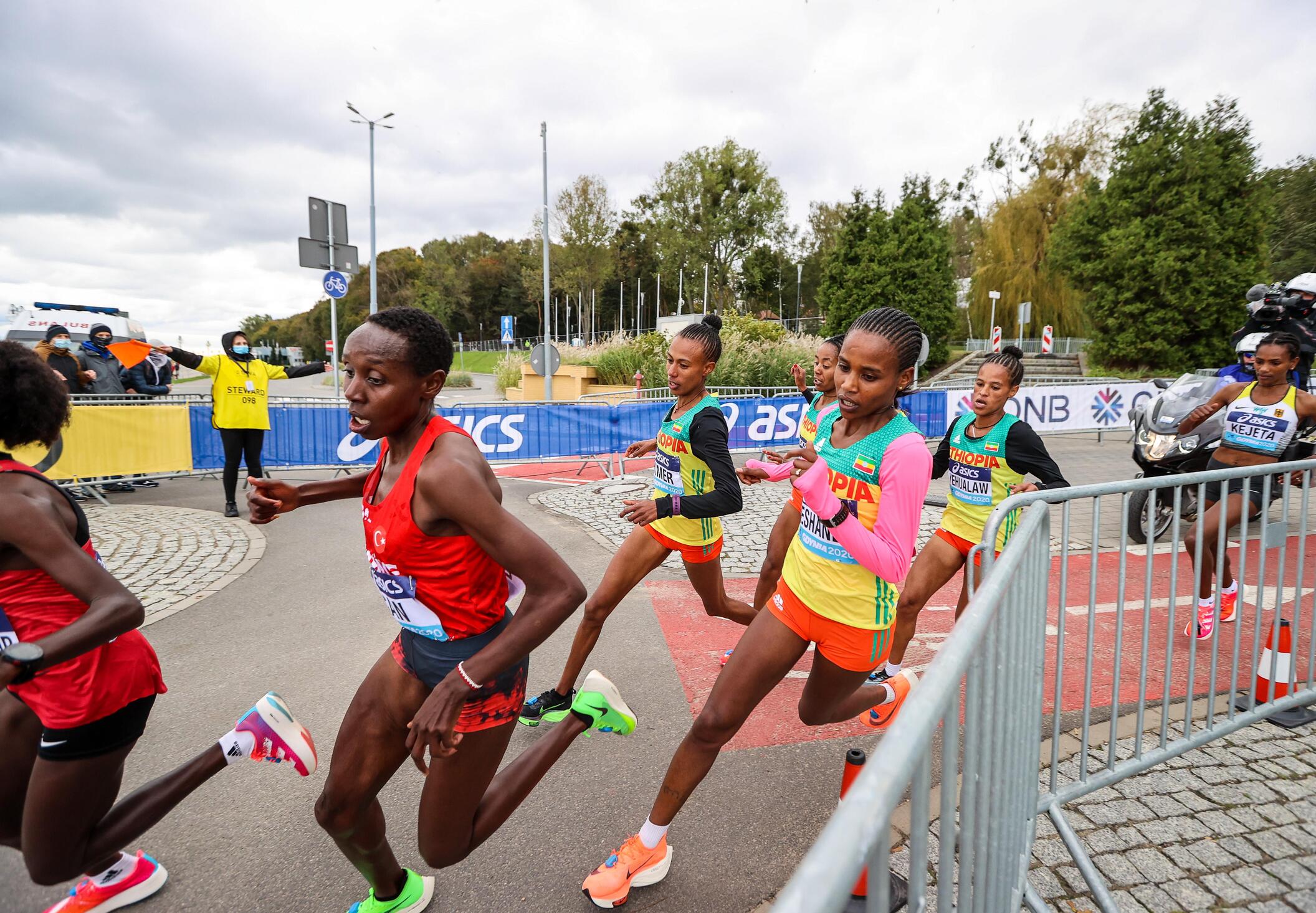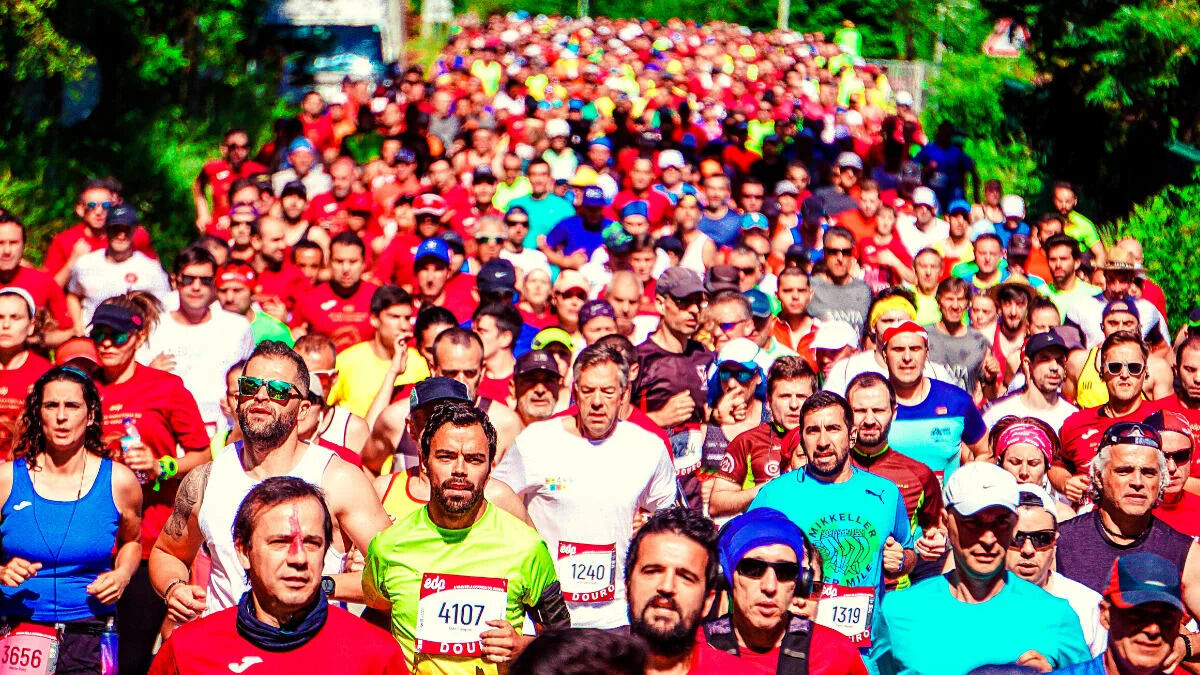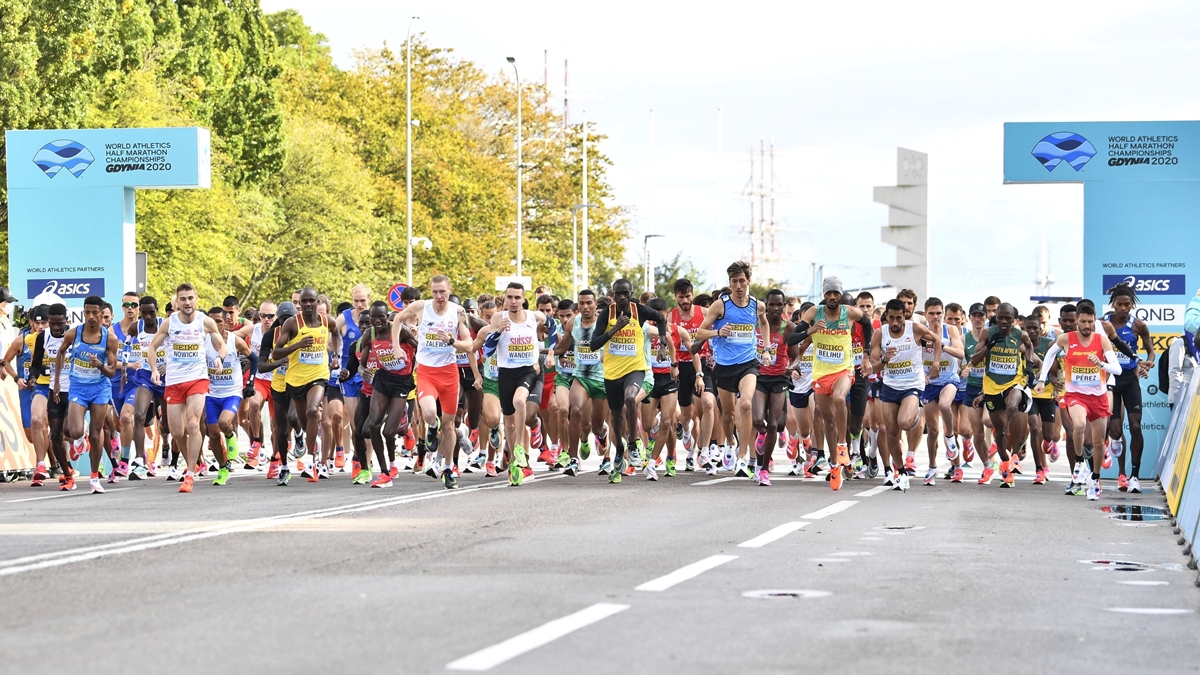

Featured
Why Is Half Marathon So Popular
Modified: January 22, 2024
Discover why the half marathon is so popular in the running community. Join us for a featured event that combines challenge, camaraderie, and accomplishment.
Introduction
Welcome to the exciting world of half marathons! This popular distance running event has gained immense popularity in recent years, attracting both seasoned runners and beginners alike. A half marathon is a race that covers a distance of 13.1 miles (or 21.1 kilometers) and offers a thrilling experience for participants.
But what makes the half marathon so appealing? Is it the challenge and accomplishment of completing a long-distance race? Or is it the sense of community and camaraderie that comes with participating in such events? In this article, we will explore the reasons behind the growing popularity of half marathons and delve into the physical and mental benefits they offer.
With the rise of fitness trends and a greater emphasis on leading a healthy lifestyle, more and more people are looking for ways to challenge themselves physically and mentally. Half marathons provide the perfect platform for individuals to test their limits and push themselves to achieve new goals.
Besides the personal satisfaction of completing a half marathon, participants often find themselves immersed in a supportive and inspiring environment. The energetic atmosphere of race day, with crowds cheering and fellow runners pushing each other forward, is incomparable.
Furthermore, half marathons are no longer limited to elite athletes. They have become increasingly accessible for all skill levels, catering to both competitive runners and those simply looking to embark on a new fitness journey. Whether you are a seasoned marathoner or a beginner taking your first steps into the world of running, there is a half marathon event for you.
As we dive into the details, we will explore the physical and mental benefits that come with training for and participating in a half marathon. From improved cardiovascular health and increased endurance to the boost in self-confidence and mental resilience, half marathons offer a holistic approach to overall well-being.
In the following sections, we will also discuss the community and social aspects of half marathon events, where participants come together as a collective to support and inspire one another. We will touch upon the training and preparation required for a successful half marathon experience, as well as highlight some of the most popular half marathon events around the world.
So, whether you are a seasoned runner looking to take on a new challenge or someone seeking a way to dive into the world of fitness and running, join us on this journey to discover why the half marathon has become such a beloved and celebrated event!
The Appeal of Half Marathons
Half marathons have emerged as a popular choice among runners of all levels and backgrounds. The 13.1-mile distance strikes a balance between the achievable challenge of a marathon and the quicker pace of shorter races. This unique combination of distance and intensity makes half marathons highly appealing to a wide range of participants.
One of the key factors that contribute to the appeal of half marathons is the sense of accomplishment that comes with completing the race. Crossing the finish line after completing 13.1 miles is a significant achievement, one that brings a sense of pride and fulfillment. It is a testament to the hard work, dedication, and perseverance put into training for the event.
Moreover, half marathons provide a platform for individuals to challenge themselves physically and mentally. The training required to prepare for a half marathon pushes runners to their limits, helping them build strength, endurance, and stamina. This process of pushing through barriers and surpassing personal goals is highly rewarding and serves as a driving force for many participants.
Another aspect that makes half marathons appealing is the opportunity to be a part of a vibrant and supportive running community. The running culture surrounding these events is infectious, with runners from all walks of life coming together to share their passion for the sport. The sense of camaraderie among participants is truly unique, as they cheer each other on, provide encouragement, and celebrate achievements both big and small.
Half marathons also offer a chance to explore new locations and experience the thrill of running in different cities or scenic routes. Many events are organized in picturesque and iconic settings, providing runners with stunning views and memorable experiences. From running through city streets to winding trails in nature, the diverse range of courses adds an element of adventure to the race.
Additionally, half marathons are inclusive and accessible, catering to a wide range of runners. Unlike marathons, which may require years of training and experience, half marathons can be tackled by both experienced runners and beginners. This inclusivity has greatly contributed to the growing popularity of the event and encourages people from all walks of life to take part.
Ultimately, the appeal of half marathons lies in the unique combination of physical challenge, personal achievement, and community support. Whether it’s the sense of accomplishment, the opportunity to push personal boundaries, or the vibrant atmosphere of race day, half marathons provide a fulfilling and exhilarating experience for all who participate.
Physical and Mental Benefits
Participating in a half marathon not only provides a sense of accomplishment but also offers numerous physical and mental benefits. The combination of endurance training, cardiovascular exercise, and mental resilience required to complete a half marathon contributes to overall well-being.
From a physical standpoint, training for and running a half marathon demands dedication and commitment to a regular exercise routine. The consistent mileage and long runs involved in the training process help improve cardiovascular fitness, enhancing heart health and increasing lung capacity. As a result, runners often experience improved endurance, allowing them to handle physical exertion for longer durations.
Engaging in regular running and endurance training has also been associated with weight management. The calorie burn during training sessions, coupled with the muscle-building benefits of running, can contribute to maintaining a healthy body weight. Running also helps build lean muscle mass, which in turn boosts metabolism and aids in weight management.
Moreover, the physical benefits of half marathons extend beyond the cardiovascular system. Running promotes bone density, strengthening bones and reducing the risk of osteoporosis. It can also help improve joint stability, leading to better overall joint health and reduced risk of injuries, such as knee pain or instability.
In addition to these physical benefits, participating in a half marathon can yield significant mental advantages. Running releases endorphins, known as the “feel-good” hormones, which enhance mood and reduce stress levels. Regular exercise, including training for a half marathon, has been linked to improved mental health, reduced symptoms of depression and anxiety, and increased self-esteem.
The mental resilience developed through half marathon training translates into other aspects of life as well. Overcoming physical and mental challenges during training and the race itself helps build mental toughness and a can-do attitude. This newfound resilience and mental strength can be applied to various situations, allowing individuals to face and overcome obstacles in different areas of their lives.
Half marathon training also provides an opportunity for self-reflection and goal setting. Setting targets, creating a training plan, and achieving milestones throughout the training process boosts self-confidence and develops a sense of discipline and purpose. Crossing the finish line of a half marathon reaffirms the belief in one’s capabilities and instills a sense of achievement that extends beyond the race itself.
Overall, the physical and mental benefits of participating in a half marathon are undeniable. Improved cardiovascular health, increased endurance, weight management, enhanced mental well-being, and a sense of accomplishment are just some of the many positive effects runners can experience. By challenging themselves both physically and mentally, participants not only reap these benefits but also develop a lifelong appreciation for the transformative power of running.
Accessibility for All
Gone are the days when running a half marathon was considered a daunting task accessible only to elite athletes. Today, half marathons have become increasingly inclusive, welcoming runners of all ages, abilities, and backgrounds. This accessibility is a major factor behind the growing popularity of half marathons around the world.
One of the reasons why half marathons are accessible to a wide range of participants is the flexible training requirements. With proper guidance and a well-designed training plan, individuals can gradually build up their endurance and prepare for the race at their own pace. This allows beginners and novice runners to embark on their half marathon journey with confidence.
In addition, the distance and pace of a half marathon are more attainable for many compared to a full marathon. It strikes a balance between the significant challenge of a marathon and the speed-focused nature of shorter races like 5K or 10K. This makes half marathons an attractive option for runners who want to push their limits without committing to the intense training required for a full marathon.
Furthermore, the variety of half marathon events caters to different preferences and goals. From themed races and charity events to trail runs and virtual races, there is a wide range of options available. This allows participants to choose an event that aligns with their interests and motivations, making the experience more enjoyable and rewarding.
The inclusive nature of half marathons also extends to physical abilities. Many events offer accommodations for individuals with disabilities, providing wheelchair-accessible routes and other necessary arrangements. This ensures that everyone, regardless of their physical capabilities, can take part and experience the joy of crossing the finish line.
Participating in a half marathon is also a family-friendly affair. Some events feature races specifically designed for children, encouraging families to engage in active and healthy lifestyles together. This fosters a sense of community and bonding, as families train together and celebrate achievements on race day.
Additionally, half marathon events often have generous cut-off times, allowing participants to complete the race at a comfortable pace. This feature ensures that even those who may not be the fastest runners can still enjoy the experience and be celebrated for their accomplishment.
The accessibility of half marathons goes beyond just the race itself. Training resources, online communities, and running clubs provide support, guidance, and encouragement to aspiring runners. These resources offer valuable information, training plans, and tips to help individuals embark on their half marathon journey with confidence.
Overall, the accessibility of half marathons has played a significant role in their growing popularity. Whether you are a seasoned runner seeking a new challenge or a beginner looking to embark on a fitness journey, the wide range of options and inclusive atmosphere of half marathon events ensures there is something for everyone. It is this accessibility that has made the half marathon a thriving and cherished running tradition.
Community and Social Aspect
One of the most remarkable aspects of participating in a half marathon is the strong sense of community and the vibrant social atmosphere. These events bring together runners from all walks of life, creating a supportive and inspiring network of individuals with a shared passion for running.
The community aspect of half marathons is evident from the moment participants arrive at the race venue. The energy and excitement in the air are palpable as runners gather, exchange stories, and prepare for the challenge ahead. The camaraderie among participants is readily apparent, with experienced runners motivating and encouraging newcomers.
The social interactions during a half marathon extend beyond the race itself. Many events organize pre-race events, such as expos and meetups, where runners have the opportunity to connect with fellow participants, share training experiences, and build friendships. These events serve as a platform for runners to bond, exchange tips, and support each other throughout the training journey and on race day.
During the race, the community spirit is amplified as runners cheer each other on, offering words of encouragement and support. Strangers become companions as they push each other forward, motivated by the collective energy and shared determination. The shared experience of overcoming physical and mental challenges creates a strong bond among participants, fostering a sense of unity and connection.
The community and social aspect of half marathons is not limited to race day alone. Online running communities and social media groups provide a platform for runners to connect, share experiences, and offer advice. These platforms create a virtual support network that extends beyond the boundaries of physical location, allowing runners from different parts of the world to inspire and motivate one another.
Participating in half marathons also offers an opportunity to contribute to a greater cause. Many events partner with charities and fundraising initiatives, giving runners the chance to run for a purpose. This aspect adds a deeper sense of meaning to the event, as participants know that their participation is making a positive impact on the lives of others. The shared commitment to a common cause further strengthens the sense of community among runners.
For many, the community and social aspect of half marathons is a powerful motivator. The support and encouragement received from fellow runners play a crucial role in pushing through difficult moments during training and on race day. Sharing the journey with like-minded individuals creates a sense of belonging and fosters a positive mindset that propels participants to achieve their goals.
Furthermore, the community aspect extends beyond just the runners. Spectators, volunteers, and race organizers also contribute to the vibrant atmosphere. Crowds lining the course, cheering on the participants, and offering words of encouragement provide an extra boost of motivation. The dedication and support of volunteers who ensure a smooth race experience are an integral part of creating a memorable and inclusive event.
In essence, the community and social aspect of half marathons creates a welcoming and inspiring environment for runners. The sense of camaraderie, support, and shared experiences create lifelong memories and friendships. The positivity and encouragement from the running community often extend far beyond the race, leaving a lasting impact on the participants’ lives.
Training and Preparation
Preparing for a half marathon requires dedicated training and preparation to ensure a successful and enjoyable experience. Taking the time to establish a structured training plan and gradually increase mileage is crucial to build the necessary endurance, strength, and mental resilience needed for race day.
A well-designed training plan for a half marathon typically spans several weeks, gradually increasing the distance and intensity of training runs. This approach allows the body to adapt to the demands of long-distance running, reducing the risk of injury and increasing overall performance.
Training for a half marathon involves a combination of running, cross-training, and strength exercises. Regular running sessions on different terrains and at varying paces help improve endurance, speed, and cardiovascular fitness. Cross-training activities such as cycling or swimming provide opportunities for low-impact workouts to promote recovery and maintain overall fitness.
Strength training exercises are also essential for half marathon preparation. Incorporating exercises that target core muscles, leg strength, and stability helps improve running form and prevent injuries. These exercises can include squats, lunges, planks, and resistance band workouts, among others.
It is important to gradually increase the weekly mileage and incorporate long runs into the training schedule. Long runs serve to build both physical and mental endurance, simulating the distance and conditions of the actual race. Gradually increasing the length of these runs helps runners become more comfortable with the distance and pace required on race day.
Alongside physical training, proper nutrition and hydration are key components of half marathon preparation. A well-balanced diet that includes carbohydrates, protein, healthy fats, and plenty of fruits and vegetables fuels the body with the necessary nutrients for energy and recovery. Hydrating before, during, and after runs is crucial to maintain performance and prevent dehydration.
Rest and recovery are also critical factors in half marathon training. Rest days allow the body to repair and rebuild muscles, reducing the risk of overuse injuries. Adequate sleep and recovery practices such as stretching, foam rolling, and incorporating restorative activities like yoga or meditation help recharge both the body and mind.
Mental preparation is equally important in successfully completing a half marathon. Developing mental resilience and positive self-talk is essential when faced with challenges during training and on race day. Setting realistic goals, visualizing success, and staying positive throughout the training process contribute to overall mental preparedness.
Finally, participating in shorter races or practice runs leading up to the half marathon can provide valuable insights and opportunities to fine-tune pacing strategies and assess overall readiness. These races can help runners gauge their progress, build confidence, and gain race-day experience.
Overall, training and preparation for a half marathon require a holistic approach encompassing physical conditioning, mental toughness, proper nutrition, and adequate rest. By following a well-structured training plan and adopting healthy habits, participants can maximize their performance and ensure a rewarding half marathon experience.
Popular Half Marathon Events
Half marathons have gained immense popularity worldwide, with a plethora of events held in various locations throughout the year. These events offer unique experiences and challenges, attracting runners from all corners of the globe. Let’s explore some of the most popular half marathon events that have captivated the running community.
The TCS New York City Half Marathon is one of the most iconic and sought-after half marathons in the world. This event takes runners through the heart of Manhattan, passing famous landmarks such as Central Park, Times Square, and the Statue of Liberty. The electric atmosphere, stunning course, and the opportunity to run in one of the most vibrant cities in the world make this event a bucket list race for many.
In Europe, the Barcelona Half Marathon stands out as a favorite among runners. With its stunning Mediterranean backdrop, this event allows participants to take in the beauty of Barcelona’s architecture and scenery. The relatively flat course and ideal weather conditions make it an attractive choice for runners of all levels.
Down under, the Sydney Half Marathon in Australia draws participants from around the world. The course takes runners along the stunning Sydney Harbour, with views of the iconic Sydney Opera House and Harbour Bridge. The lively atmosphere, scenic route, and friendly Aussie spirit create an unforgettable race experience.
The Rock ‘n’ Roll Half Marathon series is also immensely popular, with events held in cities like Las Vegas, Nashville, and San Diego. These races combine the thrill of running with live music performances along the course, creating a festive and high-energy atmosphere. Participants get to enjoy the rhythm and beat of the music as they run, making for a unique and entertainment-filled race experience.
In Asia, the Tokyo Half Marathon attracts thousands of runners eager to explore the vibrant capital of Japan. The course takes participants through the bustling streets, passing by famous landmarks such as the Imperial Palace and Tokyo Tower. The rich cultural experience and the opportunity to soak in the unique blend of tradition and modernity make this event highly desirable.
Another highly anticipated event is the Great North Run in Newcastle, England. This half marathon is the largest of its kind in the United Kingdom, with tens of thousands of participants taking part each year. The race follows a scenic route through the city, crossing the Tyne Bridge and finishing on the picturesque coastline. The lively crowds make for an incredible cheering experience and a true celebration of running.
These are just a few examples of the many popular half marathon events around the world. Each event offers its own unique charm, whether it’s the scenic routes, vibrant atmospheres, or the opportunity to run in iconic locations. Regardless of the event chosen, participating in a half marathon allows runners to immerse themselves in the spirit of the local community and partake in an unforgettable running experience.
Conclusion
The popularity of half marathons continues to soar as more people embrace the challenge, community, and overall experience that these events provide. The appeal of half marathons lies in their ability to offer a sense of accomplishment, physical and mental benefits, accessibility for all, and a strong sense of community. Participants find joy in pushing their limits, achieving personal goals, and immersing themselves in a supportive running community.
Training for a half marathon not only improves cardiovascular fitness and endurance but also boosts mental resilience and self-confidence. The physical and mental benefits extend far beyond the race day, enhancing overall well-being and fostering a positive mindset. The inclusivity and accessibility of half marathons have made them a welcoming platform for runners of all abilities and experience levels.
Half marathons also provide an avenue for forging connections, making new friends, and experiencing a sense of belonging. The vibrant atmosphere on race day creates a spirited environment where participants cheer each other on, share stories, and celebrate achievements. The running community, both in-person and online, offers support, motivation, and inspiration throughout the training journey and beyond.
From world-renowned events like the New York City Half Marathon to local races in picturesque destinations, half marathons provide runners with memorable experiences and opportunities to explore new locations. Each event comes with its own unique charm, offering a chance to discover different cultures, landmarks, and landscapes.
In conclusion, the surge in popularity of half marathons can be attributed to the combination of physical and mental challenges, the supportive and inclusive community, and the unforgettable race-day experiences. Whether you are an experienced runner seeking a new challenge or a beginner taking the first steps into the world of running, participating in a half marathon promises a journey filled with growth, camaraderie, and personal triumph.
